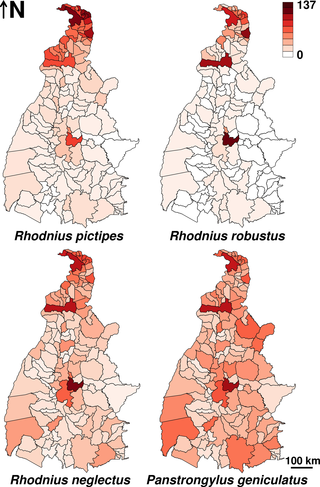PLOS Neglected Tropical Diseases ( IF 3.4 ) Pub Date : 2017-11-16 , DOI: 10.1371/journal.pntd.0006035 Raíssa N. Brito , David E. Gorla , Liléia Diotaiuti , Anália C. F. Gomes , Rita C. M. Souza , Fernando Abad-Franch

|
Background
Insecticide spraying efficiently controls house infestation by triatomine bugs, the vectors of Trypanosoma cruzi. The strategy, however, is ineffective against sylvatic triatomines, which can transmit Chagas disease by invading (without colonizing) man-made structures. Despite growing awareness of the relevance of these transmission dynamics, the drivers of house invasion by sylvatic triatomines remain poorly understood.
Methods/Findings
About 12,000 sylvatic triatomines were caught during routine surveillance in houses of Tocantins state, Brazil, in 2005–2013. Using negative binomial regression, information-theoretic model evaluation/averaging, and external model validation, we investigated the effects of regional (Amazon/Cerrado), landscape (preservation/disturbance), and climate covariates (temperature, rainfall) on the municipality-aggregated numbers of house-invading Rhodnius pictipes, R. robustus, R. neglectus, and Panstrongylus geniculatus. House invasion by R. pictipes and R. robustus was overall more frequent in the Amazon biome, tended to increase in municipalities with more well-preserved land, and decreased in rainier municipalities. Across species, invasion decreased with higher landscape-disturbance levels and in hotter-day municipalities. Invasion by R. neglectus and P. geniculatus increased somewhat with more land at intermediate disturbance and peaked in average-rainfall municipalities. Temperature effects were more pronounced on P. geniculatus than on Rhodnius spp.
Conclusions
We report widespread, frequent house invasion by sylvatic triatomines in the Amazon–Cerrado transition. Our analyses indicate that readily available environmental metrics may help predict the risk of contact between sylvatic triatomines and humans at coarse geographic scales, and hint at specific hypotheses about climate and deforestation effects on those vectors–with some taxon-specific responses and some seemingly general trends. Thus, our focal species appear to be quite sensitive to higher temperatures, and might be less common in more heavily-disturbed than in better-preserved environments. This study illustrates, in sum, how entomological routine-surveillance data can be efficiently used for Chagas disease risk prediction and stratification when house-colonizing vectors are absent.
中文翻译:

亚马逊-塞拉多过渡期中由传染性恰加斯病引起的房屋入侵的驱动因素:对市政汇总监视数据的全州范围的多年评估
背景
喷洒杀虫剂可有效控制由锥虫(克氏锥虫的媒介)引起的家蝇侵扰。然而,该策略对于对抗sylvatic triatomines无效,sylvatic triatomines可以通过入侵(没有定植)人造结构来传播恰加斯病。尽管人们越来越意识到这些传播动力学的相关性,但对sylvatic triatomines入侵房屋的驱动因素仍然知之甚少。
方法/发现
在2005年至2013年期间,在巴西Tocantins州的房屋进行例行监视期间,捕获了约12,000个sylvatic triatomines。使用负二项式回归,信息理论模型评估/平均和外部模型验证,我们研究了区域(亚马逊/塞拉多),景观(保护/干扰)和气候协变量(温度,降雨量)对市级汇总的影响侵害房屋的红景天数量,R。健壮性,R。neglectus和Panstrongylus geniculatus。R入侵房屋。pictipes和- [R。健壮的总体而言,亚马逊生物群系中的这种现象更为普遍,土地保护得更好的城市倾向于增加,而雨水较多的城市则倾向于减少。在整个物种中,随着较高的景观干扰水平以及在较热的城市中,入侵程度有所降低。R的入侵。neglectus和P。在中等干扰水平下,更多的土地使草有所增加,并在平均降雨的城市达到顶峰。温度对P的影响更为明显。geniculatus比Rhodnius属。
结论
我们报道了在亚马逊-塞拉多过渡期,sylvatic triatomines广泛且频繁地侵入房屋。我们的分析表明,现成的环境指标可能有助于预测在粗略的地理尺度上三羟甲基紫杉醇与人类之间接触的风险,并暗示有关气候和森林砍伐对这些媒介的影响的特定假设,以及某些分类群特定的响应和一些看似普遍的趋势。 。因此,我们的焦点物种似乎对高温非常敏感,与受保护程度更高的环境相比,受更严重干扰的物种可能不那么常见。总而言之,这项研究说明了在缺少房屋定殖载体的情况下,如何将昆虫学常规监测数据有效地用于南美锥虫病风险预测和分层。











































 京公网安备 11010802027423号
京公网安备 11010802027423号